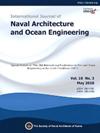Statistical study of cascade hydrodynamics and cavitation dynamics in propulsion pumps
IF 3.9
3区 工程技术
Q2 ENGINEERING, MARINE
International Journal of Naval Architecture and Ocean Engineering
Pub Date : 2025-01-01
DOI:10.1016/j.ijnaoe.2025.100665
引用次数: 0
Abstract
The propulsion pump is widely employed in ocean engineering to generate thrust for surface or underwater vehicles. The cascade provides a simplified way to investigate the flow dynamics inside a propulsion pump considering specific parameters such as solidity and blade stagger. This work develops the foil generation method by in-house code through parametrically controlling the maximum and its position of camber and thickness, the influence of which on the performance obtained by numerical simulation is studied by the multiple statistical regression covering linear and interaction terms. For isolated hydrofoils, the interaction of maximum thickness and its position plays a major role in determining the performance. For cascade configurations with variable foils, besides the thickness interaction terms, other terms influencing lift and drag are not unified for different angles of attack. The solidity insignificantly affects the regression terms. For the cascade with the fixed foils, the solidity, axial velocity, and incidence angle all have an impact on the cascade foil's performance. The statistical loading distributions show that the isolated foil is a typical head-loading type, and the cascade foil is a body-loading type. The cascade cavitation dynamics indicate that a higher solidity and incidence angle would depress the cavitation development owing to the adjacent foil interference. This research aims to provide an instructive guide on pump blade design.
推进泵叶栅水动力与空化动力学的统计研究
推进泵在海洋工程中广泛应用,为水面或水下航行体提供推力。考虑到固体度和叶片交错等特定参数,叶栅为研究推进泵内部的流动动力学提供了一种简化的方法。本文通过参数化控制弯度和厚度的最大值及其位置,通过覆盖线性项和相互作用项的多元统计回归,研究了其对数值模拟所得性能的影响。对于孤立型水翼,最大厚度与其位置的相互作用是决定其性能的主要因素。对于变叶栅构型,除厚度相互作用项外,影响升力和阻力的其他项在不同迎角下并不统一。固体度对回归项影响不显著。对于固定叶栅,固体度、轴向速度和入射角都对叶栅的性能有影响。统计载荷分布表明,隔离叶型为典型的头部载荷型,叶栅叶型为体载荷型。叶栅空化动力学分析表明,较高的固体度和入射角可以抑制邻近叶干扰引起的空化发展。本研究旨在为水泵叶片的设计提供指导。
本文章由计算机程序翻译,如有差异,请以英文原文为准。
求助全文
约1分钟内获得全文
求助全文
来源期刊

International Journal of Naval Architecture and Ocean Engineering
ENGINEERING, MARINE-
CiteScore
4.90
自引率
4.50%
发文量
62
审稿时长
12 months
期刊介绍:
International Journal of Naval Architecture and Ocean Engineering provides a forum for engineers and scientists from a wide range of disciplines to present and discuss various phenomena in the utilization and preservation of ocean environment. Without being limited by the traditional categorization, it is encouraged to present advanced technology development and scientific research, as long as they are aimed for more and better human engagement with ocean environment. Topics include, but not limited to: marine hydrodynamics; structural mechanics; marine propulsion system; design methodology & practice; production technology; system dynamics & control; marine equipment technology; materials science; underwater acoustics; ocean remote sensing; and information technology related to ship and marine systems; ocean energy systems; marine environmental engineering; maritime safety engineering; polar & arctic engineering; coastal & port engineering; subsea engineering; and specialized watercraft engineering.
 求助内容:
求助内容: 应助结果提醒方式:
应助结果提醒方式:


